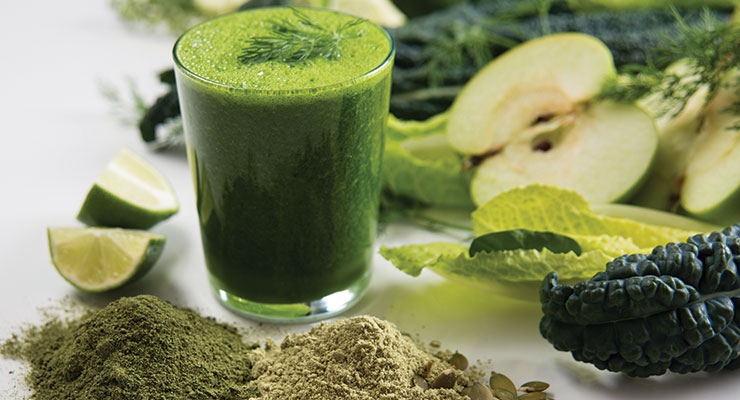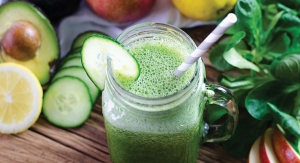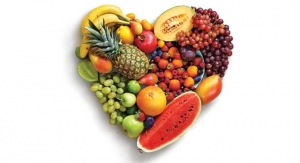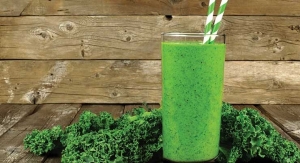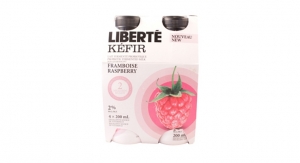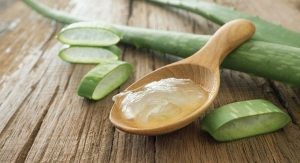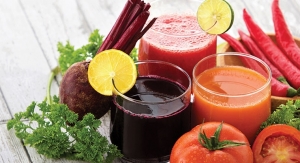Lisa Olivo, Associate Editor09.08.15
Green plants and vegetables provide a host of critical micronutrients to the body, offering essential vitamins, minerals, fiber and protein. Yet many consumers struggle to get a sufficient amount of greens in their regular diet.
However, the tide is turning as more consumers seek out natural, organic, or “clean-label” nutraceuticals with ingredients derived from plants being seen as premium. Furthermore, the growing number of vegetarians in the U.S.— accounting for 5% of the population (nearly 16 million people), of which half are vegan, according to a 2011 Harris Interactive study—has led to a rise in plant-based products. The study also reported that 33% of Americans are making an effort to incorporate some vegan and vegetarian meals into their diet more often.
Innova Market Insights reported a 22% increase in global product launches with vegetarian positioning from 2013-2014, while 47% of U.S. consumers reported increasing their intake of fruits and vegetables over the last year. Even vegetable flavors are trending, according to Innova, as a wide variety of juices, shakes and snacks are now boasting green ingredients to health conscious consumers. As green lifestyles go mainstream, suppliers are clamoring to offer convenient and effective products targeting this emerging audience.
“More people than ever before realize how important vegetables are in their diet,” observed Ron Seibold, co-founder, Pines International, Inc., Lawrence KS. “In terms of number of products, the green food market is definitely growing. It seems like nearly every company now has at least one green food or green food blend.”
Mr. Seibold sees this competitive marketplace as evidence that consumers now recognize green food supplements—including dehydrated green food powders, capsules, tablets—as well as functional foods and beverages as valuable tools for improving their diet and overall health.
Cultivating Healthy Diets
A wide variety of green ingredients are available to boost the nutritional profile of consumers’ diets, according to Margaret Gomes, marketing director, NP Nutra, Gardena, CA. “Wheatgrass, spirulina and kale have been around for a long time,” she noted, however, these products are now catching on in the U.S. as a result of generally poor public health. “Green supplements are full of nutrients, are low in sugar, are very alkalizing and can help to balance dietary acids. In this day and age people are looking for ways to optimize their health.” While such supplements are not meant to replace food, she argued green products could enhance consumers’ diets.
For those looking for nutrient density, Mr. Seibold recommended looking to cereal grasses such as wheat grass, barley grass, oat grass and rye grass, in addition to algae (spirulina, chlorella and blue-green algae) and alfalfa leaf. “There are other nutrient dense green foods such as the leaves from the Moringa tree and leaves of other nutrient-dense plants. Of course, the most common green foods are kale, spinach and other leafy greens. Other vegetables like broccoli and green beans are also green foods.”
Larry Blitz, president, Green Source Organics, Santa Barbara, CA, noted an uptick in popularity among several of its green food offerings. “We are experiencing increased demand in our organic green algae, juiced grasses and vegetable powders, specifically spirulina, chlorella, wheat, alfalfa, barley, and broccoli, kale and spinach.”
Green ingredients are not only popular for their rich vitamin and mineral profile; green leafy vegetables provide an essential source of dietary fiber, benefiting digestion, weight management and cardiovascular health, according to experts.
“In general, the darker green a vegetable, the more nutrient density and the more efficacious it is. However, a whole food version of any green vegetable will look lighter green in the dried form than the dried juice of that green vegetable,” explained Mr. Seibold. “That’s because whole green foods contain vegetable fiber, which lightens the dried version compared to dried juice.” He referenced recent interest in prebiotics and underscored the importance of vegetable fiber, which he said is especially lacking in modern diets.
Aloe Vera
Aloe vera has an extensive history of safe and efficacious use across a broad range of applications, according to Peter Hafermann, president, Improve USA, a division of Pharmachem Laboratories Inc., Kearny, NJ. He cited data from the International Aloe Science Council, Silver Spring, MD, which several years ago estimated the market for Aloe vera-containing products at nearly $10 billion. Mr. Hafermann added that growth of Aloe vera raw materials has continued at a steady pace of about 5% annually.
“Aloe vera is likely the largest botanical ingredient in the world. Its use spans a broad range of applications, including but not limited to oral supplements in solid dosage and liquid forms, personal care products in areas such as topicals, hair care products, tissues, wipes, wound care applications, etc.,” he noted, adding that growth in the segment has been spurred particularly by use in beverage applications. A wide range of aloe drinks has hit store shelves in recent years, both unflavored and flavored, and with and without pulp, he added.
“Most people who drink aloe drink it for the digestive health benefits,” as result of the plant’s prebiotic capabilities, commented Jeff Barrie, eastern regional sales manager, Aloecorp, Keene, NH, who believes the next wave of popular finished products with aloe will include more oral care products, snack bars, yogurts and chews.
Marine Greens
Mintel reports have suggested that algae is an ingredient to watch, noting that it is nicely positioned for inclusion in “free-from” products, in addition to functioning as a healthy alternative for trans-fats, dairy and eggs. However, fewer than half of Western consumers are accepting of marine-based proteins, according to Mintel data. The consumer research firm advised that the benefits and safety of algae ingredients need to be made clear to consumers new to this beneficial green.
Despite some consumer hesitation, manufacturers see great potential, and launches of food and drinks with algae oil and/or algae based ingredients grew internationally between 2010 and May 2015. Such product introductions were up 23% in China, 21% in India, 21% in the U.S., 6% in Canada, 4% in Vietnam and 3% in Taiwan, according to Mintel’s Global New Products Database.
One popular marine ingredient is spirulina, which NP Nutra’s Ms. Gomes said “contains a staggering array of essential nutrients for our bodies.” She added, “Not only does it contain over 60% complete protein (almost three times as much as that found in beef), it has high concentrations of many other important vitamins and minerals, such as B complex vitamins, vitamin E, carotenoids, iron, manganese, zinc, essential fatty acids such as gamma linolenic acid (GLA), which is only otherwise found in mother’s milk, and more beta-carotene than you can find in carrots. Spirulina is also one of the few plant sources of vitamin B12, which is essential for healthy nerves and tissues.”
Ms. Gomes pointed to scientific evidence published in 2011 in Journal of Cellular & Molecular Immunology that suggested spirulina supports the immune system for people over 50 years of age. The report indicated taking spirulina as a supplement may improve immune function and ameliorate anemia in persons in this age range.
Chlorella, or Chlorella vulgaris, is another algae ingredient that possesses great nutritional benefits. “Chlorella contains an amazing amount of essential nutrients: vitamins, macrominerals, trace minerals, essential fatty acids such as GLA, complete proteins, nucleic acids (RNA and DNA), chlorophyll and a vast spectrum of phytochemicals,” said Ms. Gomes.
Portugal-based microalgae supplier Allma specializes in chlorella, which the company’s business development manager, Sofia De Mendonça, said “contains a vast array of micronutrients, from all the essential amino acids, as well as several trace minerals, vitamins A, B, C and E, and other important phytochemicals such as chlorophyll, lutein, zeaxanthin and carotenes.”
Ms. De Mendonça also underscored the microalgae’s myriad benefits for health, stating chlorella “represents a complete source of high quality protein from vegetable origin; supplies a significant amount of antioxidant pigments; is low in fat, of which around 60% are PUFAs; and it is also used as a detoxifying ingredient.”
Allma conducted a study with its Chlorella vulgaris powder using a digestive tract simulator to test its bioavailability compared to other broken cell wall chlorella products. “Results were quite positive,” said Ms. De Mendonça, “proving that Allma’s chlorella powder is as bioavailable as the microalgae that are artificially broken.” However, the artificially broken products have an increased risk of oxidation and loss of functional properties, she said.
Plant Protein
From 2013 to 2014, growth of global high protein product launches with plant-based proteins increased by 24%, according to Innova Market Insights. While soy is the clear leader in the plant protein space, pea protein has emerged as a strong and growing alternative. Innova suggested that benefits of formulating with plant proteins include their robust nutritional profile, ease of digestion and their ability to tap into the “free-from” formulation trend.
Plant proteins are ideal for today’s food market and healthy consumer, according to Kathy Lund, vice president of business development and marketing for AIDP, City of Industry, CA. “Plant proteins address the continually rising costs of other protein sources, a growing vegan market and growing awareness of whey, soy protein and other foods that lead to allergies and sensitivities,” she said.
Parabel USA Inc., Melbourne, FL, a provider of plant protein from the water lentil, or Lemnoideae, said sustainability is a key benefit to formulating with plant protein. The company’s Lemnoideae extract, branded as Lentein, offers high levels of protein and micronutrients, with the added benefit of being 100% sustainably harvested, according to the company.
Cecilia Wittbjer, Parabel’s vice president of marketing, described Lentein as being comparable in amino acid profile to whey, with 65% protein content and high levels of micronutrients, including beta-carotene, chlorophyll, folic acid and lutein. “Some proteins like pea and rice proteins are not complete proteins, however, Lentein is a complete protein with a balanced amino acid profile, and it is actually higher in amino acids than any other plant protein, including soy,” Ms. Wittbjer claimed.
It is minimally processed through a cold-pressed production process, she explained. In addition, Lentein is produced in closed aquafarms with no runoff, in which the water the plant is grown in is recycled. Water lentil has a speedy 24-hour life cycle, so it is harvested daily, leading to high production levels. Ms. Wittbjer believes its rapid availability positions the ingredient to be part of the world’s food security solution as the global population is expected to reach 9 billion by 2050.
Tel Aviv, Israel-based Hinoman produces Mankai, a vegetable whole-protein ingredient designed for use in functional foods and beverages. Derived from what Ron Salpeter, CEO of Hinoman, described as “the world’s smallest green leaf vegetable,” Mankai is cultivated in a sustainable hydro-culture.
According to the company, the nutritional composition of the Mankai microgreen ingredient has been determined to be high in protein (at least 45-48%), low in fat (7-8%), with 24-45% carbohydrate content. Analysis of the amino acid composition found Mankai is a rich source of the entire group of essential amino acids.
“We have studied everything there is to know about this little plant,” said Mr. Salpeter. “It’s a bred species protected under the International Treaty for the Protection of Breeders Rights (a legal instrument). We specialized in our patented strain of duckweed, and fully integrated it into our eco-friendly cultivation system.” The benefit of this, he said, is that the company can offer constancy all year—a sustainable high protein plant of the same size, of nearly the same composition, with high quality control at a steady price point.
“Unlike algae, unlike kale, it’s not too small or too big to be an ingredient that fits into the production lines of the food industry as a drop-in product,” stated Mr. Salpeter, pointing out that a piece of Mankai is similar in size to a grain of flour.
Trending Formats
One health and wellness trend driving growth in the green food supplement category is the rise of cold-pressed juices, which are health-focused beverages that often feature vegetable flavors and varieties. Innova Market Insights reported more than 84% growth in global cold-pressed juice product launches between 2013-2014, with North America leading in new product development.
The rise in popularity of green juices has led to innovation in other finished product categories. “Companies are getting very creative, because consumers want more whole foods and less junk,” observed Ms. Gomes of NP Nutra. “I have seen everything from green superfood nutrition bars, to green superfood packets for adding into smoothies and drinks. I have even seen kale soda by Hansen’s. It’s exciting because mainstream companies are starting to ditch their artificial ingredients and opt for more wholesome supplements.”
Green powders are also a popular delivery format for these supplements, giving a nutritional boost to juices and smoothies made at home, or blended in yogurts or soups. Mr. Seibold of Pines International observed development in the green smoothie trend, which consumers are making at home with their blenders or juicers, combining fresh, whole vegetables, along with dehydrated green food powder in order to make their “green smoothie even greener.”
He added,“There is still a strong interest in pre-sweetened blends that one simply mixes with water, but the trend is toward simple blends or single ingredient green foods. Many consumers now want to create their own recipes and make smoothies, changing their recipes on a daily basis, rather than getting locked in with one company’s green food recipe blend.”
While whole food powder solutions are more common, Ms. Lund of AIDP said concentrated pills also provide nutrition and convenience for consumers. “Most people cannot eat the amount of food required to get the recommended nutrients,” she said, which is why a small pill or tablet could offer support.
Mr. Blitz of Green Source Organics said the company witnessed food manufacturers looking into green “inclusion in bars, snacks and coatings.”
Ms. Wittbjer with Parabel also noted interest in its ingredient for inclusion in bars, pastas and yogurts.
To meet the growing demand for green functional foods, Allma launched a concept that blends rice cereal with chlorella powder to create a crispy snack and ingredient solution. The company’s Chlorella Crunches were designed in a range of sizes, shapes and flavors and with varying concentrations of chlorella. They are free of GMOs, gluten and major allergens. In addition, Allma developed a prototype concentrated liquid chlorella that is a hydrophilic extract designed for ease of use in food and beverage applications.
Market Challenges
While the fact that green food products are derived from the earth is a huge draw for the category, the unpredictability of Mother Nature can be difficult for suppliers and product developers. Manufacturers are subject to issues such as seasonal limitations, drought, environmental contamination and even natural variation in crop yield. Furthermore, those companies producing organic and non-GMO ingredients need to grow their crops under strict protocols to ensure purity.
Mr. Blitz said Green Source Organics’ focus on organic greens has made seasonal supply constraints a consideration for the company. GSO has also made a concerted effort to reduce the time from harvest to drying during its production process in order to retain more macronutrients in its end product. This, Mr. Blitz said, is a “difficult part of the process.”
Improve USA’s organically grown Aloe vera is produced without the use of herbicides, fungicides and pesticides, which benefits end consumers, but the company must be vigilant to ensure the protection of its crops against natural predators. Mr. Hafermann added that “geographic diversity is critical in minimizing crop risk. For example, we want to ensure that Aloe vera is grown in small- to medium-size plots, distant from each other in case of poor weather, so that all the plants are not affected by poor conditions at the same time. Also, Aloe vera plants cannot live in cold climates. Frost will kill the plant, hence we find most Aloe vera grown in Mexico below the frost line, about 200 miles south of the U.S. border.”
Cultivating organic, non-GMO cereal grasses and alfalfa is subject to similar challenges. Mr. Seibold explained the process of obtaining certified organic and Non-GMO Project Verified status as being an undertaking in itself.
“Obtaining that verification was extremely time consuming and difficult because GMO alfalfa is now being grown commercially,” he added, “and the pollen is easily carried by the wind, causing contamination of alfalfa at great distances. As a result of our experience, even though organic certification is supposed to require non-GMO seed, we have found that certified organic seed could test positive for GMO markers. This may be why we have been the only company to successfully meet the genetic testing standards of the Non-GMO Project.” However, aside from the issues related to contamination of genetically modified pollen, “alfalfa is a great crop to grow,” Mr. Seibold said.
Cereal grasses, on the other hand, are much more difficult to produce. “Cereal grasses are annuals,” he noted. “In other words, the plant has only one growing season, once each year, produces grain and then dies. In the 1930s and 1940s, Charles Schnabel and other scientists extensively researched the stages of growth for cereal grass and learned that they all reach a point of maximum nutrition called the ‘jointing stage’ in the early spring, usually after a winter of slow growth in often-freezing temperatures. The jointing stage is the point at which the plant quits storing green food nutrition and starts using that stored nutrition to support the production of the grain.”
This is the stage of growth in which quality cereal grass products are harvested, Mr. Seibold said. “When harvested at that jointing stage, the yield for cereal grass is about 500 pounds per acre. That is 500 pounds per acre for a crop that has to be planted once each year compared with 2,000 pounds per acre for alfalfa for each harvest with four or more harvests per year for five or more years after one planting. Thus, quality cereal grass is much more expensive and difficult to produce than quality alfalfa.”
Future Outlook
Looking ahead, Mr. Blitz believes there will be an even stronger push toward transparency and increased consumer scrutiny over how green crops are produced. “We expect an increase in all things organic, especially the greens segment. As population awareness continues, we’ll strive at supplying ingredients that will improve the health of people, their pets and the planet.”
The popularity of these products has increased product development, but also led to less expensive, lower quality ingredients coming into the market, according to Mr. Seibold. “After 40 years of our nurturing the green food segment, it is frustrating to see so many poor quality green food products on the market, making hyperbolic claims that we old timers would never make,” he said. “It is a concern for us who have devoted our lives to the green foods market that many consumers will go away from the green food category disillusioned and thinking that our message of ‘eat more green’ with green food powders is just a bunch of nonsense.”
When it comes to low-grade products, he said, the assumption of these disillusioned customers is probably correct, and may discourage further use.
However, “there are also consumers who recognize that not all green food products are the same and who will try different products and recognize that a green food ought to be green, not brown, yellow or gray or disguised using spirulina or chocolate to hide the true color.”
He predicted quality products will survive in the long run. “Green food tablets and capsules will also continue to grow in popularity as convenient ways to ensure one’s daily greens. Overall, the entire green food category will grow as the awareness of the importance of eating more greens continues to grow.”
However, the tide is turning as more consumers seek out natural, organic, or “clean-label” nutraceuticals with ingredients derived from plants being seen as premium. Furthermore, the growing number of vegetarians in the U.S.— accounting for 5% of the population (nearly 16 million people), of which half are vegan, according to a 2011 Harris Interactive study—has led to a rise in plant-based products. The study also reported that 33% of Americans are making an effort to incorporate some vegan and vegetarian meals into their diet more often.
Innova Market Insights reported a 22% increase in global product launches with vegetarian positioning from 2013-2014, while 47% of U.S. consumers reported increasing their intake of fruits and vegetables over the last year. Even vegetable flavors are trending, according to Innova, as a wide variety of juices, shakes and snacks are now boasting green ingredients to health conscious consumers. As green lifestyles go mainstream, suppliers are clamoring to offer convenient and effective products targeting this emerging audience.
“More people than ever before realize how important vegetables are in their diet,” observed Ron Seibold, co-founder, Pines International, Inc., Lawrence KS. “In terms of number of products, the green food market is definitely growing. It seems like nearly every company now has at least one green food or green food blend.”
Mr. Seibold sees this competitive marketplace as evidence that consumers now recognize green food supplements—including dehydrated green food powders, capsules, tablets—as well as functional foods and beverages as valuable tools for improving their diet and overall health.
Cultivating Healthy Diets
A wide variety of green ingredients are available to boost the nutritional profile of consumers’ diets, according to Margaret Gomes, marketing director, NP Nutra, Gardena, CA. “Wheatgrass, spirulina and kale have been around for a long time,” she noted, however, these products are now catching on in the U.S. as a result of generally poor public health. “Green supplements are full of nutrients, are low in sugar, are very alkalizing and can help to balance dietary acids. In this day and age people are looking for ways to optimize their health.” While such supplements are not meant to replace food, she argued green products could enhance consumers’ diets.
For those looking for nutrient density, Mr. Seibold recommended looking to cereal grasses such as wheat grass, barley grass, oat grass and rye grass, in addition to algae (spirulina, chlorella and blue-green algae) and alfalfa leaf. “There are other nutrient dense green foods such as the leaves from the Moringa tree and leaves of other nutrient-dense plants. Of course, the most common green foods are kale, spinach and other leafy greens. Other vegetables like broccoli and green beans are also green foods.”
Larry Blitz, president, Green Source Organics, Santa Barbara, CA, noted an uptick in popularity among several of its green food offerings. “We are experiencing increased demand in our organic green algae, juiced grasses and vegetable powders, specifically spirulina, chlorella, wheat, alfalfa, barley, and broccoli, kale and spinach.”
Green ingredients are not only popular for their rich vitamin and mineral profile; green leafy vegetables provide an essential source of dietary fiber, benefiting digestion, weight management and cardiovascular health, according to experts.
“In general, the darker green a vegetable, the more nutrient density and the more efficacious it is. However, a whole food version of any green vegetable will look lighter green in the dried form than the dried juice of that green vegetable,” explained Mr. Seibold. “That’s because whole green foods contain vegetable fiber, which lightens the dried version compared to dried juice.” He referenced recent interest in prebiotics and underscored the importance of vegetable fiber, which he said is especially lacking in modern diets.
Aloe Vera
Aloe vera has an extensive history of safe and efficacious use across a broad range of applications, according to Peter Hafermann, president, Improve USA, a division of Pharmachem Laboratories Inc., Kearny, NJ. He cited data from the International Aloe Science Council, Silver Spring, MD, which several years ago estimated the market for Aloe vera-containing products at nearly $10 billion. Mr. Hafermann added that growth of Aloe vera raw materials has continued at a steady pace of about 5% annually.
“Aloe vera is likely the largest botanical ingredient in the world. Its use spans a broad range of applications, including but not limited to oral supplements in solid dosage and liquid forms, personal care products in areas such as topicals, hair care products, tissues, wipes, wound care applications, etc.,” he noted, adding that growth in the segment has been spurred particularly by use in beverage applications. A wide range of aloe drinks has hit store shelves in recent years, both unflavored and flavored, and with and without pulp, he added.
“Most people who drink aloe drink it for the digestive health benefits,” as result of the plant’s prebiotic capabilities, commented Jeff Barrie, eastern regional sales manager, Aloecorp, Keene, NH, who believes the next wave of popular finished products with aloe will include more oral care products, snack bars, yogurts and chews.
Marine Greens
Mintel reports have suggested that algae is an ingredient to watch, noting that it is nicely positioned for inclusion in “free-from” products, in addition to functioning as a healthy alternative for trans-fats, dairy and eggs. However, fewer than half of Western consumers are accepting of marine-based proteins, according to Mintel data. The consumer research firm advised that the benefits and safety of algae ingredients need to be made clear to consumers new to this beneficial green.
Despite some consumer hesitation, manufacturers see great potential, and launches of food and drinks with algae oil and/or algae based ingredients grew internationally between 2010 and May 2015. Such product introductions were up 23% in China, 21% in India, 21% in the U.S., 6% in Canada, 4% in Vietnam and 3% in Taiwan, according to Mintel’s Global New Products Database.
One popular marine ingredient is spirulina, which NP Nutra’s Ms. Gomes said “contains a staggering array of essential nutrients for our bodies.” She added, “Not only does it contain over 60% complete protein (almost three times as much as that found in beef), it has high concentrations of many other important vitamins and minerals, such as B complex vitamins, vitamin E, carotenoids, iron, manganese, zinc, essential fatty acids such as gamma linolenic acid (GLA), which is only otherwise found in mother’s milk, and more beta-carotene than you can find in carrots. Spirulina is also one of the few plant sources of vitamin B12, which is essential for healthy nerves and tissues.”
Ms. Gomes pointed to scientific evidence published in 2011 in Journal of Cellular & Molecular Immunology that suggested spirulina supports the immune system for people over 50 years of age. The report indicated taking spirulina as a supplement may improve immune function and ameliorate anemia in persons in this age range.
Chlorella, or Chlorella vulgaris, is another algae ingredient that possesses great nutritional benefits. “Chlorella contains an amazing amount of essential nutrients: vitamins, macrominerals, trace minerals, essential fatty acids such as GLA, complete proteins, nucleic acids (RNA and DNA), chlorophyll and a vast spectrum of phytochemicals,” said Ms. Gomes.
Portugal-based microalgae supplier Allma specializes in chlorella, which the company’s business development manager, Sofia De Mendonça, said “contains a vast array of micronutrients, from all the essential amino acids, as well as several trace minerals, vitamins A, B, C and E, and other important phytochemicals such as chlorophyll, lutein, zeaxanthin and carotenes.”
Ms. De Mendonça also underscored the microalgae’s myriad benefits for health, stating chlorella “represents a complete source of high quality protein from vegetable origin; supplies a significant amount of antioxidant pigments; is low in fat, of which around 60% are PUFAs; and it is also used as a detoxifying ingredient.”
Allma conducted a study with its Chlorella vulgaris powder using a digestive tract simulator to test its bioavailability compared to other broken cell wall chlorella products. “Results were quite positive,” said Ms. De Mendonça, “proving that Allma’s chlorella powder is as bioavailable as the microalgae that are artificially broken.” However, the artificially broken products have an increased risk of oxidation and loss of functional properties, she said.
Plant Protein
From 2013 to 2014, growth of global high protein product launches with plant-based proteins increased by 24%, according to Innova Market Insights. While soy is the clear leader in the plant protein space, pea protein has emerged as a strong and growing alternative. Innova suggested that benefits of formulating with plant proteins include their robust nutritional profile, ease of digestion and their ability to tap into the “free-from” formulation trend.
Plant proteins are ideal for today’s food market and healthy consumer, according to Kathy Lund, vice president of business development and marketing for AIDP, City of Industry, CA. “Plant proteins address the continually rising costs of other protein sources, a growing vegan market and growing awareness of whey, soy protein and other foods that lead to allergies and sensitivities,” she said.
Parabel USA Inc., Melbourne, FL, a provider of plant protein from the water lentil, or Lemnoideae, said sustainability is a key benefit to formulating with plant protein. The company’s Lemnoideae extract, branded as Lentein, offers high levels of protein and micronutrients, with the added benefit of being 100% sustainably harvested, according to the company.
Cecilia Wittbjer, Parabel’s vice president of marketing, described Lentein as being comparable in amino acid profile to whey, with 65% protein content and high levels of micronutrients, including beta-carotene, chlorophyll, folic acid and lutein. “Some proteins like pea and rice proteins are not complete proteins, however, Lentein is a complete protein with a balanced amino acid profile, and it is actually higher in amino acids than any other plant protein, including soy,” Ms. Wittbjer claimed.
It is minimally processed through a cold-pressed production process, she explained. In addition, Lentein is produced in closed aquafarms with no runoff, in which the water the plant is grown in is recycled. Water lentil has a speedy 24-hour life cycle, so it is harvested daily, leading to high production levels. Ms. Wittbjer believes its rapid availability positions the ingredient to be part of the world’s food security solution as the global population is expected to reach 9 billion by 2050.
Tel Aviv, Israel-based Hinoman produces Mankai, a vegetable whole-protein ingredient designed for use in functional foods and beverages. Derived from what Ron Salpeter, CEO of Hinoman, described as “the world’s smallest green leaf vegetable,” Mankai is cultivated in a sustainable hydro-culture.
According to the company, the nutritional composition of the Mankai microgreen ingredient has been determined to be high in protein (at least 45-48%), low in fat (7-8%), with 24-45% carbohydrate content. Analysis of the amino acid composition found Mankai is a rich source of the entire group of essential amino acids.
“We have studied everything there is to know about this little plant,” said Mr. Salpeter. “It’s a bred species protected under the International Treaty for the Protection of Breeders Rights (a legal instrument). We specialized in our patented strain of duckweed, and fully integrated it into our eco-friendly cultivation system.” The benefit of this, he said, is that the company can offer constancy all year—a sustainable high protein plant of the same size, of nearly the same composition, with high quality control at a steady price point.
“Unlike algae, unlike kale, it’s not too small or too big to be an ingredient that fits into the production lines of the food industry as a drop-in product,” stated Mr. Salpeter, pointing out that a piece of Mankai is similar in size to a grain of flour.
Trending Formats
One health and wellness trend driving growth in the green food supplement category is the rise of cold-pressed juices, which are health-focused beverages that often feature vegetable flavors and varieties. Innova Market Insights reported more than 84% growth in global cold-pressed juice product launches between 2013-2014, with North America leading in new product development.
The rise in popularity of green juices has led to innovation in other finished product categories. “Companies are getting very creative, because consumers want more whole foods and less junk,” observed Ms. Gomes of NP Nutra. “I have seen everything from green superfood nutrition bars, to green superfood packets for adding into smoothies and drinks. I have even seen kale soda by Hansen’s. It’s exciting because mainstream companies are starting to ditch their artificial ingredients and opt for more wholesome supplements.”
Green powders are also a popular delivery format for these supplements, giving a nutritional boost to juices and smoothies made at home, or blended in yogurts or soups. Mr. Seibold of Pines International observed development in the green smoothie trend, which consumers are making at home with their blenders or juicers, combining fresh, whole vegetables, along with dehydrated green food powder in order to make their “green smoothie even greener.”
He added,“There is still a strong interest in pre-sweetened blends that one simply mixes with water, but the trend is toward simple blends or single ingredient green foods. Many consumers now want to create their own recipes and make smoothies, changing their recipes on a daily basis, rather than getting locked in with one company’s green food recipe blend.”
While whole food powder solutions are more common, Ms. Lund of AIDP said concentrated pills also provide nutrition and convenience for consumers. “Most people cannot eat the amount of food required to get the recommended nutrients,” she said, which is why a small pill or tablet could offer support.
Mr. Blitz of Green Source Organics said the company witnessed food manufacturers looking into green “inclusion in bars, snacks and coatings.”
Ms. Wittbjer with Parabel also noted interest in its ingredient for inclusion in bars, pastas and yogurts.
To meet the growing demand for green functional foods, Allma launched a concept that blends rice cereal with chlorella powder to create a crispy snack and ingredient solution. The company’s Chlorella Crunches were designed in a range of sizes, shapes and flavors and with varying concentrations of chlorella. They are free of GMOs, gluten and major allergens. In addition, Allma developed a prototype concentrated liquid chlorella that is a hydrophilic extract designed for ease of use in food and beverage applications.
Market Challenges
While the fact that green food products are derived from the earth is a huge draw for the category, the unpredictability of Mother Nature can be difficult for suppliers and product developers. Manufacturers are subject to issues such as seasonal limitations, drought, environmental contamination and even natural variation in crop yield. Furthermore, those companies producing organic and non-GMO ingredients need to grow their crops under strict protocols to ensure purity.
Mr. Blitz said Green Source Organics’ focus on organic greens has made seasonal supply constraints a consideration for the company. GSO has also made a concerted effort to reduce the time from harvest to drying during its production process in order to retain more macronutrients in its end product. This, Mr. Blitz said, is a “difficult part of the process.”
Improve USA’s organically grown Aloe vera is produced without the use of herbicides, fungicides and pesticides, which benefits end consumers, but the company must be vigilant to ensure the protection of its crops against natural predators. Mr. Hafermann added that “geographic diversity is critical in minimizing crop risk. For example, we want to ensure that Aloe vera is grown in small- to medium-size plots, distant from each other in case of poor weather, so that all the plants are not affected by poor conditions at the same time. Also, Aloe vera plants cannot live in cold climates. Frost will kill the plant, hence we find most Aloe vera grown in Mexico below the frost line, about 200 miles south of the U.S. border.”
Cultivating organic, non-GMO cereal grasses and alfalfa is subject to similar challenges. Mr. Seibold explained the process of obtaining certified organic and Non-GMO Project Verified status as being an undertaking in itself.
“Obtaining that verification was extremely time consuming and difficult because GMO alfalfa is now being grown commercially,” he added, “and the pollen is easily carried by the wind, causing contamination of alfalfa at great distances. As a result of our experience, even though organic certification is supposed to require non-GMO seed, we have found that certified organic seed could test positive for GMO markers. This may be why we have been the only company to successfully meet the genetic testing standards of the Non-GMO Project.” However, aside from the issues related to contamination of genetically modified pollen, “alfalfa is a great crop to grow,” Mr. Seibold said.
Cereal grasses, on the other hand, are much more difficult to produce. “Cereal grasses are annuals,” he noted. “In other words, the plant has only one growing season, once each year, produces grain and then dies. In the 1930s and 1940s, Charles Schnabel and other scientists extensively researched the stages of growth for cereal grass and learned that they all reach a point of maximum nutrition called the ‘jointing stage’ in the early spring, usually after a winter of slow growth in often-freezing temperatures. The jointing stage is the point at which the plant quits storing green food nutrition and starts using that stored nutrition to support the production of the grain.”
This is the stage of growth in which quality cereal grass products are harvested, Mr. Seibold said. “When harvested at that jointing stage, the yield for cereal grass is about 500 pounds per acre. That is 500 pounds per acre for a crop that has to be planted once each year compared with 2,000 pounds per acre for alfalfa for each harvest with four or more harvests per year for five or more years after one planting. Thus, quality cereal grass is much more expensive and difficult to produce than quality alfalfa.”
Future Outlook
Looking ahead, Mr. Blitz believes there will be an even stronger push toward transparency and increased consumer scrutiny over how green crops are produced. “We expect an increase in all things organic, especially the greens segment. As population awareness continues, we’ll strive at supplying ingredients that will improve the health of people, their pets and the planet.”
The popularity of these products has increased product development, but also led to less expensive, lower quality ingredients coming into the market, according to Mr. Seibold. “After 40 years of our nurturing the green food segment, it is frustrating to see so many poor quality green food products on the market, making hyperbolic claims that we old timers would never make,” he said. “It is a concern for us who have devoted our lives to the green foods market that many consumers will go away from the green food category disillusioned and thinking that our message of ‘eat more green’ with green food powders is just a bunch of nonsense.”
When it comes to low-grade products, he said, the assumption of these disillusioned customers is probably correct, and may discourage further use.
However, “there are also consumers who recognize that not all green food products are the same and who will try different products and recognize that a green food ought to be green, not brown, yellow or gray or disguised using spirulina or chocolate to hide the true color.”
He predicted quality products will survive in the long run. “Green food tablets and capsules will also continue to grow in popularity as convenient ways to ensure one’s daily greens. Overall, the entire green food category will grow as the awareness of the importance of eating more greens continues to grow.”

